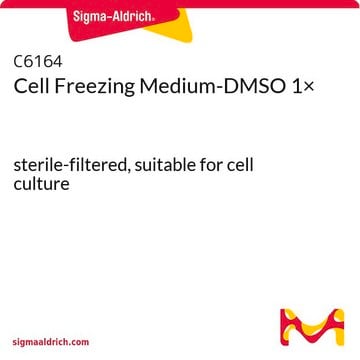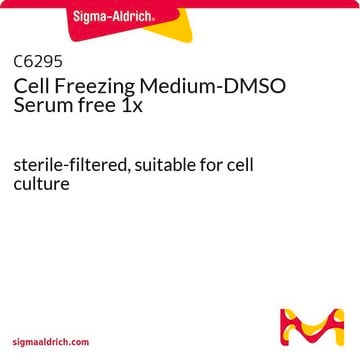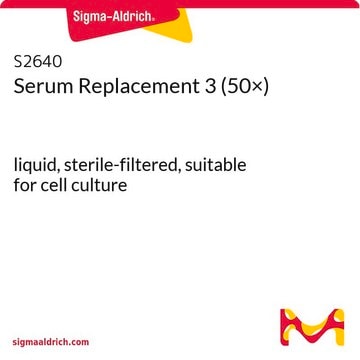Z1653
pZerve™
Cryopreservation Solution
Synonyme(s) :
DMSO-free freezing solution
Se connecterpour consulter vos tarifs contractuels et ceux de votre entreprise/organisme
About This Item
Code UNSPSC :
12352207
Nomenclature NACRES :
NA.75
Produits recommandés
Technique(s)
cryopreservation: suitable
Température de stockage
2-8°C
Description générale
pZerve is a cryopreservation solution that does not contain dimethyl sulfoxide (DMSO), fetal bovine serum or other animal protein. Optimal recovery is achieved through elimination of these harmful components. pZerve is ready to use, does not require any dilution or further processing, and can be used for cells cultured in serum free medium or with serum containing medium.
Application
pZerve has been successfully used with the following cell types including, but not limited to:
- Mast Cells
- Dendritic Cells
- Mesenchymal Cells
- LNCaP – Metastatic Prostate Adenocarcinoma, Human
- LS 180 – Colon, Adenocarcinoma, Human
- 293 – Transformed Primary Embryonal Kidney, Human
Notes préparatoires
Recommended Freezing and Thawing Protocol
Freezing:
1. Examine the culture for healthy growth, confluency, etc. and the absence of contamination.
2. If freezing adherent cells, remove using 0.25% trypsin for 1 to 3 minutes at 37 °C.
NOTE: Some cell lines grown in serum-free medium may be sensitive to 0.25% trypsin and therefore, may require less trypsin or the addition of a trypsin inhibitor. Wash cells after incubating with trypsin.
3. Perform a cell count to determine the total number of viable cells. Cell viability should be greater than 80%, and cells should be in late log phase or pre-confluency growth phase.
4. Centrifuge cells at 600 to 800 RPM for 10 minutes. Remove supernatant and save 3 to 5 mL for sterility testing (e.g. thioglycollate, brain heart infusion, etc.) and mycoplasma testing.
5. Resuspend the cells gently in an appropriate volume of pZerve at a concentration of 1x106 - 1x107 cells/ml. Some cell types such as hybridomas and myelomas may require an increase in cell density.
6. Dispense the cell suspension in 1 to 2 mL aliquots in plastic or glass ampules.
7. Seal ampules and store at room temperature for 30 minutes with occasional, gentle agitation to expose cells completely to cryopreservative.
8. Place ampules in an insulated container and store in a -20°C freezer for one hour. Remove insulation and transfer to -70 °C freezer for one hour. Do not store at -70 °C for more than two hours. Transfer vials to vapor phase of liquid nitrogen and store for 24 hours before transferring to liquid phase. The suggested optimum cooling rate is 1 °C per minute for most cell types.
Recovery:
1. Remove vials from freezer and rapidly thaw in a 37 °C water bath.
2. Wipe vials with 70% ethanol.
3. Transfer cells to a culture flask and slowly add the appropriate volume of growth medium (2 to 5 mL).
4. Accurate viability counts (i.e., trypan blue dye exclusion) should be performed after at least 2 hours recovery at 37 °C.
5. Medium should be changed within 24 hours.
If desired, pZerve may be removed by washing in the following manner:
1. Transfer cells to a 15ml centrifuge tube and slowly add 2 to 3 mL of complete growth medium (cells are more fragile after thawing).
2. Centrifuge at 400 to 600 RPM for approximately 5 minutes.
3. Decant and transfer the cells to a culture flask with the appropriate volume of growth medium.
4. Cell viability count should be performed at least two hours after recovery.
IMPORTANT: Before terminating a culture, it is recommended that you test entire freeze/thaw cycle to ensure sterility of the culture and cell viability before long term storage.
Freezing:
1. Examine the culture for healthy growth, confluency, etc. and the absence of contamination.
2. If freezing adherent cells, remove using 0.25% trypsin for 1 to 3 minutes at 37 °C.
NOTE: Some cell lines grown in serum-free medium may be sensitive to 0.25% trypsin and therefore, may require less trypsin or the addition of a trypsin inhibitor. Wash cells after incubating with trypsin.
3. Perform a cell count to determine the total number of viable cells. Cell viability should be greater than 80%, and cells should be in late log phase or pre-confluency growth phase.
4. Centrifuge cells at 600 to 800 RPM for 10 minutes. Remove supernatant and save 3 to 5 mL for sterility testing (e.g. thioglycollate, brain heart infusion, etc.) and mycoplasma testing.
5. Resuspend the cells gently in an appropriate volume of pZerve at a concentration of 1x106 - 1x107 cells/ml. Some cell types such as hybridomas and myelomas may require an increase in cell density.
6. Dispense the cell suspension in 1 to 2 mL aliquots in plastic or glass ampules.
7. Seal ampules and store at room temperature for 30 minutes with occasional, gentle agitation to expose cells completely to cryopreservative.
8. Place ampules in an insulated container and store in a -20°C freezer for one hour. Remove insulation and transfer to -70 °C freezer for one hour. Do not store at -70 °C for more than two hours. Transfer vials to vapor phase of liquid nitrogen and store for 24 hours before transferring to liquid phase. The suggested optimum cooling rate is 1 °C per minute for most cell types.
Recovery:
1. Remove vials from freezer and rapidly thaw in a 37 °C water bath.
2. Wipe vials with 70% ethanol.
3. Transfer cells to a culture flask and slowly add the appropriate volume of growth medium (2 to 5 mL).
4. Accurate viability counts (i.e., trypan blue dye exclusion) should be performed after at least 2 hours recovery at 37 °C.
5. Medium should be changed within 24 hours.
If desired, pZerve may be removed by washing in the following manner:
1. Transfer cells to a 15ml centrifuge tube and slowly add 2 to 3 mL of complete growth medium (cells are more fragile after thawing).
2. Centrifuge at 400 to 600 RPM for approximately 5 minutes.
3. Decant and transfer the cells to a culture flask with the appropriate volume of growth medium.
4. Cell viability count should be performed at least two hours after recovery.
IMPORTANT: Before terminating a culture, it is recommended that you test entire freeze/thaw cycle to ensure sterility of the culture and cell viability before long term storage.
Autres remarques
- pZerve only contains human protein.
- pZerve is ready to use an does not require any dilution or further processing.
- pZerve is sterile membrane filtered.
- Mix well before use.
- DO NOT DILUTE.
Informations légales
pZerve is a trademark of Protide Pharmaceuticals, Inc.
Code de la classe de stockage
12 - Non Combustible Liquids
Classe de danger pour l'eau (WGK)
WGK 3
Point d'éclair (°F)
Not applicable
Point d'éclair (°C)
Not applicable
Certificats d'analyse (COA)
Recherchez un Certificats d'analyse (COA) en saisissant le numéro de lot du produit. Les numéros de lot figurent sur l'étiquette du produit après les mots "Lot" ou "Batch".
Déjà en possession de ce produit ?
Retrouvez la documentation relative aux produits que vous avez récemment achetés dans la Bibliothèque de documents.
Les clients ont également consulté
Madeleine Rådinger et al.
Current protocols in immunology, Chapter 7, Unit 7-Unit 7 (2010-09-04)
Antigen-mediated mast cell activation is a pivotal step in the initiation of allergic disorders including anaphylaxis and atopy. To date, studies aimed at investigating the mechanisms regulating these responses, and studies designed to identify potential ways to prevent them, have
Arnold S Kirshenbaum et al.
Leukemia research, 27(8), 677-682 (2003-06-13)
Two novel stem cell factor (SCF) dependent human mast cell lines, designated LAD 1 and 2, were established from bone marrow aspirates from a patient with mast cell sarcoma/leukemia. LAD 1 and 2 cells have the ultrastructural features of human
Notre équipe de scientifiques dispose d'une expérience dans tous les secteurs de la recherche, notamment en sciences de la vie, science des matériaux, synthèse chimique, chromatographie, analyse et dans de nombreux autres domaines..
Contacter notre Service technique










